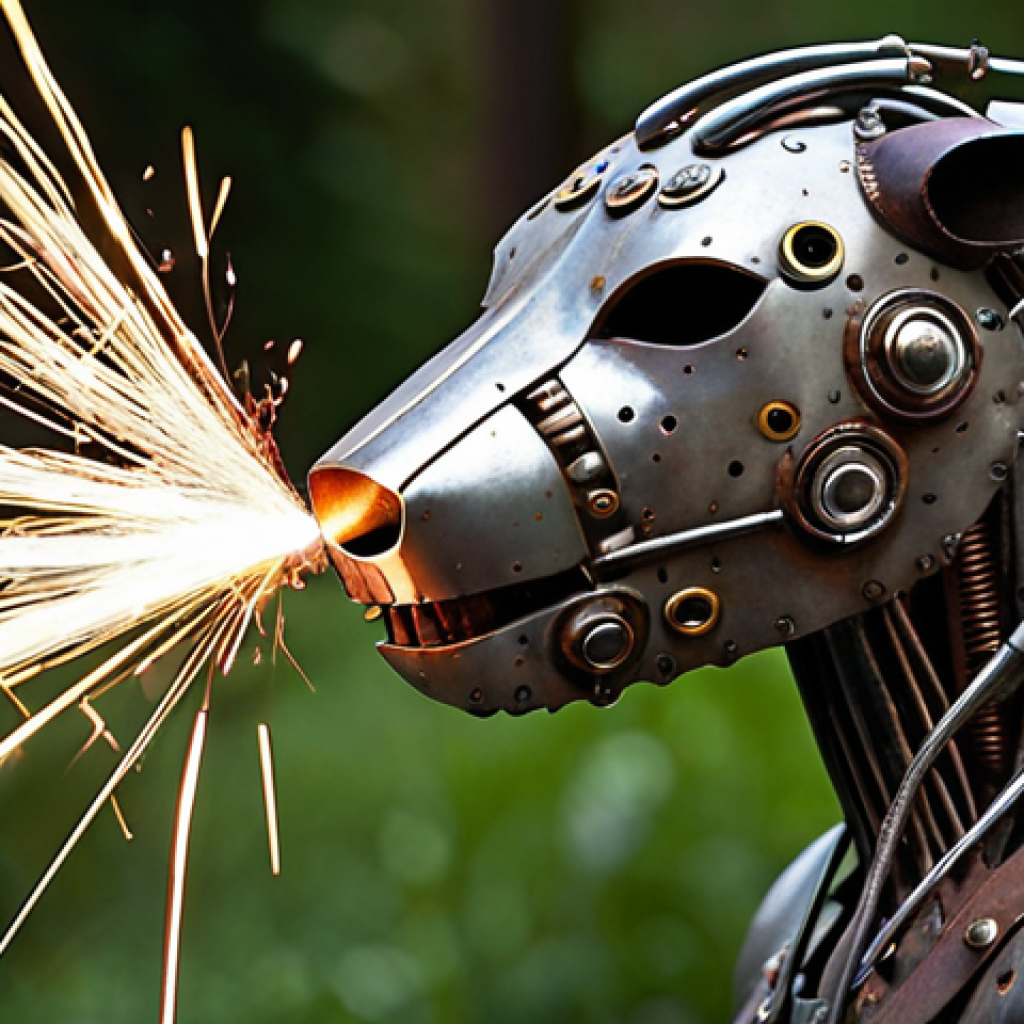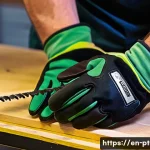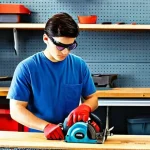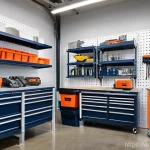Ever since I picked up my dad’s old drill, I’ve been fascinated by the possibilities hidden within power tools. Sure, they’re meant for construction and repairs, but I started seeing them as instruments – tools to sculpt, carve, and create in ways traditional art materials simply couldn’t.
I’m not talking about just fixing things, but completely transforming metal, wood, and even plastic into something beautiful and thought-provoking. It’s a world where sparks fly, the air fills with the scent of burning metal, and the possibilities are limited only by your imagination.
What started as a hobby has become a true passion, and I’m excited to share what I’ve learned with you. Let’s delve into the details in the following article.
Alright, let’s dive into the electrifying world where power tools meet artistry!
Forging Beauty: Transforming Scrap into Sculptures
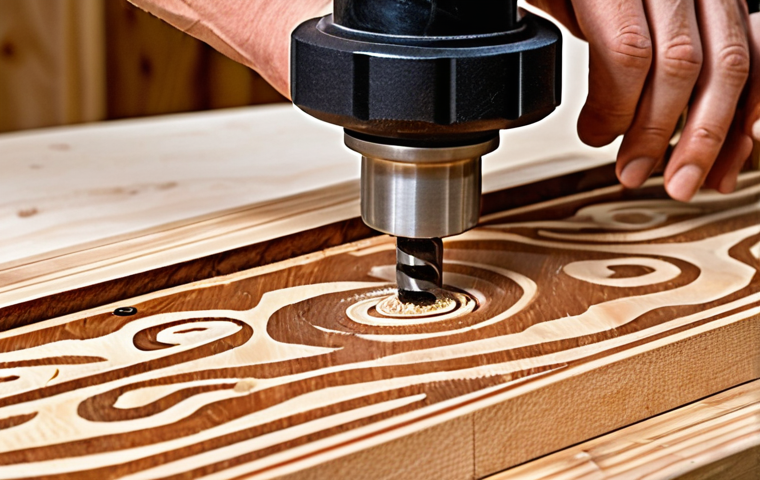
The magic really begins when you start looking beyond the intended purpose of these tools. I’m talking about taking discarded metal – old car parts, scrap iron, even rusty pipes – and turning it into something completely new.
It’s like giving these forgotten materials a second life, a chance to become something beautiful again. It’s not just about welding pieces together; it’s about understanding the properties of the metal, how it responds to heat, pressure, and manipulation.
It requires patience, a keen eye for design, and a willingness to experiment.
Taming the Torch: Mastering Welding Techniques
Welding is absolutely essential. I started with MIG welding – it’s relatively easy to learn and great for joining thicker pieces. But as I got more ambitious, I moved into TIG welding for finer details and more intricate designs.
And man, TIG welding is an art form in itself! The control you have is amazing, but it demands a steady hand and a good understanding of amperage, gas flow, and electrode selection.
The Dance of Destruction: Controlled Cutting and Shaping
Cutting torches, plasma cutters, angle grinders – these are tools that might seem destructive, but in the right hands, they can be incredibly precise.
An angle grinder with a flap disc can smooth out rough edges and blend welds seamlessly. A plasma cutter allows you to cut intricate shapes out of sheet metal with incredible speed and accuracy.
It’s all about controlled aggression, knowing where to apply force and where to hold back.
Woodworking Wonders: Power Tools as Carving Instruments
I primarily focus on metal, but wood offers a completely different tactile experience. It is also very forgiving. When you mess up with metal, you have to cut things or grind things down.
With wood, you can fill gaps or re-sand the surface.
Routers: Beyond the Edge
Forget using a router just for edging! With the right bits and templates, you can carve intricate patterns, create textured surfaces, and even hollow out entire forms.
I’ve used my router to create everything from decorative bowls to abstract wall hangings. It’s all about thinking outside the box and pushing the boundaries of what the tool is “supposed” to do.
Chainsaw Art: From Log to Life
I never thought I’d be wielding a chainsaw to create art, but there’s something incredibly freeing about it. The raw power, the speed, the sheer volume of material you can remove – it’s unlike anything else.
It’s all about quick, decisive movements. You’re not just cutting wood; you’re revealing the form that’s already hidden inside.
The Painter’s Arsenal: Power Tools for Surface Design
Power tools can also be used to prepare the surface of your art or create really interesting texture effects.
Angle Grinders: More Than Just Grinding
Using an angle grinder with different attachments can create incredible textures on wood and metal. Wire wheels can add a rustic, weathered look. Flap discs can smooth surfaces or create subtle gradients.
And even sanding discs can be used to create unique patterns.
Heat Guns: Taming Plastics and Paints
Heat guns aren’t just for removing paint; they can be used to manipulate plastics, create textured effects on canvas, and even seal wood. I’ve used a heat gun to bend acrylic sheets into flowing sculptures, create interesting patterns on epoxy resin, and even caramelize the surface of wood for a unique finish.
Safety First: Protecting Yourself and Your Art
Working with power tools is exhilarating, but safety *always* comes first. I’ve seen far too many accidents, and I’ve had a few close calls myself. It’s just not worth it to cut corners when your health and safety are on the line.
Gear Up: Essential Protective Equipment
* Eye Protection: Safety glasses or a full-face shield are non-negotiable. Flying sparks, wood chips, and metal shards can cause serious eye damage.
* Hearing Protection: Power tools are loud. Over time, that noise can lead to permanent hearing loss. Wear earplugs or earmuffs.
* Gloves: Protect your hands from cuts, burns, and vibrations. Leather gloves are a good all-around choice, but specialized gloves are available for specific tasks like welding or sanding.
* Respirator: Dust, fumes, and vapors can be incredibly harmful to your lungs. Wear a respirator appropriate for the materials you’re working with.
Know Your Tools: Respect the Power
Every power tool is different. Take the time to read the manual, understand its limitations, and practice using it before you start on your actual project.
Don’t push the tool beyond its capabilities. It’s better to take your time and do it right than to rush and risk an accident.
Finding Your Voice: Developing a Unique Style
Ultimately, the most important thing is to find your own artistic voice. Don’t be afraid to experiment, to try new things, to break the rules. The beauty of power tool art is that there are no limits.
Inspiration Everywhere: Seek and Synthesize
Inspiration can come from anywhere – nature, architecture, music, even other artists. The key is to absorb those influences and then filter them through your own unique perspective.
Don’t just copy what others are doing; use their work as a springboard for your own creativity.
Embrace the Imperfect: Let the Tool Guide You
Power tools aren’t perfect. They can be unpredictable, messy, and even a little bit dangerous. But that’s part of their charm.
Embrace the imperfections, the unexpected textures, the happy accidents. Sometimes, the most beautiful art comes from letting the tool guide you, rather than trying to control it completely.
Showcasing Your Work: Connecting with the World
Creating art is only half the battle. The other half is sharing your work with the world.
Online Presence: Building Your Brand
* Instagram: A visual platform is perfect for showcasing your sculptures. Use high-quality photos and videos, and engage with your followers. * Etsy/Online Store: If you’re selling your art, an online store is essential.
Make sure your listings are clear, concise, and visually appealing. * Website: A professional website gives you complete control over your brand and allows you to showcase your work in a more comprehensive way.
Local Connections: Art Fairs and Galleries
Don’t neglect the offline world. Art fairs, galleries, and local craft shows are great places to meet potential buyers, network with other artists, and get feedback on your work.
—Here’s an example of a table that you can consider including in the article:
| Tool | Material | Technique | Artistic Effect |
|---|---|---|---|
| Angle Grinder | Metal/Wood | Grinding/Sanding | Textured surface, smooth finish |
| Welder (MIG/TIG) | Metal | Joining | Sculptural forms, intricate details |
| Router | Wood | Carving/Shaping | Patterns, textures, hollow forms |
| Heat Gun | Plastic/Paint | Heating/Bending | Molded shapes, unique finishes |
Power Tool Art: From Workshop to Wall – Unleashing CreativityThe world of art is constantly evolving, and artists are always seeking new ways to express themselves.
One exciting frontier is the realm of power tool art – where the raw power and precision of tools designed for construction and manufacturing are harnessed to create stunning sculptures, intricate carvings, and innovative surface designs.
Forget the paintbrushes and chisels; let’s talk about the angle grinders, welders, and routers transforming scrap into masterpieces. Forging Beauty: Transforming Scrap into SculpturesThe magic really begins when you start looking beyond the intended purpose of these tools.
I’m talking about taking discarded metal – old car parts, scrap iron, even rusty pipes – and turning it into something completely new. It’s like giving these forgotten materials a second life, a chance to become something beautiful again.
It’s not just about welding pieces together; it’s about understanding the properties of the metal, how it responds to heat, pressure, and manipulation.
It requires patience, a keen eye for design, and a willingness to experiment. Taming the Torch: Mastering Welding TechniquesWelding is absolutely essential.
I started with MIG welding – it’s relatively easy to learn and great for joining thicker pieces. But as I got more ambitious, I moved into TIG welding for finer details and more intricate designs.
And man, TIG welding is an art form in itself! The control you have is amazing, but it demands a steady hand and a good understanding of amperage, gas flow, and electrode selection.
The Dance of Destruction: Controlled Cutting and ShapingCutting torches, plasma cutters, angle grinders – these are tools that might seem destructive, but in the right hands, they can be incredibly precise.
An angle grinder with a flap disc can smooth out rough edges and blend welds seamlessly. A plasma cutter allows you to cut intricate shapes out of sheet metal with incredible speed and accuracy.
It’s all about controlled aggression, knowing where to apply force and where to hold back. Woodworking Wonders: Power Tools as Carving InstrumentsI primarily focus on metal, but wood offers a completely different tactile experience.
It is also very forgiving. When you mess up with metal, you have to cut things or grind things down. With wood, you can fill gaps or re-sand the surface.
Routers: Beyond the EdgeForget using a router just for edging! With the right bits and templates, you can carve intricate patterns, create textured surfaces, and even hollow out entire forms.
I’ve used my router to create everything from decorative bowls to abstract wall hangings. It’s all about thinking outside the box and pushing the boundaries of what the tool is “supposed” to do.
Chainsaw Art: From Log to LifeI never thought I’d be wielding a chainsaw to create art, but there’s something incredibly freeing about it. The raw power, the speed, the sheer volume of material you can remove – it’s unlike anything else.
It’s all about quick, decisive movements. You’re not just cutting wood; you’re revealing the form that’s already hidden inside. The Painter’s Arsenal: Power Tools for Surface DesignPower tools can also be used to prepare the surface of your art or create really interesting texture effects.
Angle Grinders: More Than Just GrindingUsing an angle grinder with different attachments can create incredible textures on wood and metal. Wire wheels can add a rustic, weathered look.
Flap discs can smooth surfaces or create subtle gradients. And even sanding discs can be used to create unique patterns. Heat Guns: Taming Plastics and PaintsHeat guns aren’t just for removing paint; they can be used to manipulate plastics, create textured effects on canvas, and even seal wood.
I’ve used a heat gun to bend acrylic sheets into flowing sculptures, create interesting patterns on epoxy resin, and even caramelize the surface of wood for a unique finish.
Safety First: Protecting Yourself and Your ArtWorking with power tools is exhilarating, but safety *always* comes first. I’ve seen far too many accidents, and I’ve had a few close calls myself.
It’s just not worth it to cut corners when your health and safety are on the line. Gear Up: Essential Protective Equipment* Eye Protection: Safety glasses or a full-face shield are non-negotiable.
Flying sparks, wood chips, and metal shards can cause serious eye damage. * Hearing Protection: Power tools are loud. Over time, that noise can lead to permanent hearing loss.
Wear earplugs or earmuffs. * Gloves: Protect your hands from cuts, burns, and vibrations. Leather gloves are a good all-around choice, but specialized gloves are available for specific tasks like welding or sanding.
* Respirator: Dust, fumes, and vapors can be incredibly harmful to your lungs. Wear a respirator appropriate for the materials you’re working with. Know Your Tools: Respect the PowerEvery power tool is different.
Take the time to read the manual, understand its limitations, and practice using it before you start on your actual project. Don’t push the tool beyond its capabilities.
It’s better to take your time and do it right than to rush and risk an accident. Finding Your Voice: Developing a Unique StyleUltimately, the most important thing is to find your own artistic voice.
Don’t be afraid to experiment, to try new things, to break the rules. The beauty of power tool art is that there are no limits. Inspiration Everywhere: Seek and SynthesizeInspiration can come from anywhere – nature, architecture, music, even other artists.
The key is to absorb those influences and then filter them through your own unique perspective. Don’t just copy what others are doing; use their work as a springboard for your own creativity.
Embrace the Imperfect: Let the Tool Guide YouPower tools aren’t perfect. They can be unpredictable, messy, and even a little bit dangerous. But that’s part of their charm.
Embrace the imperfections, the unexpected textures, the happy accidents. Sometimes, the most beautiful art comes from letting the tool guide you, rather than trying to control it completely.
Showcasing Your Work: Connecting with the WorldCreating art is only half the battle. The other half is sharing your work with the world. Online Presence: Building Your Brand* Instagram: A visual platform is perfect for showcasing your sculptures.
Use high-quality photos and videos, and engage with your followers. * Etsy/Online Store: If you’re selling your art, an online store is essential. Make sure your listings are clear, concise, and visually appealing.
* Website: A professional website gives you complete control over your brand and allows you to showcase your work in a more comprehensive way. Local Connections: Art Fairs and GalleriesDon’t neglect the offline world.
Art fairs, galleries, and local craft shows are great places to meet potential buyers, network with other artists, and get feedback on your work. Here’s an example of a table that you can consider including in the article:| Tool | Material | Technique | Artistic Effect |
| ————— | ———– | ————— | ———————————— |
| Angle Grinder | Metal/Wood | Grinding/Sanding | Textured surface, smooth finish |
| Welder (MIG/TIG) | Metal | Joining | Sculptural forms, intricate details |
| Router | Wood | Carving/Shaping | Patterns, textures, hollow forms |
| Heat Gun | Plastic/Paint | Heating/Bending | Molded shapes, unique finishes |
Wrapping Up
Power tool art is more than just a craft; it’s a testament to human ingenuity and creativity. It’s about finding beauty in the unexpected, pushing boundaries, and transforming the mundane into the extraordinary. So, pick up those tools, unleash your imagination, and start creating your own power tool masterpiece. Who knows, you might just surprise yourself!
Now, go forth and make something amazing!
Happy creating!
Good to Know
1. Always disconnect power tools when changing bits or making adjustments.
2. Use the right tool for the job; don’t force a tool to do something it wasn’t designed for.
3. Keep your workspace clean and well-lit to prevent accidents.
4. Consider attending workshops or online courses to learn advanced techniques.
5. Don’t be afraid to experiment with different materials and techniques to find your unique style.
Key Takeaways
• Safety is paramount; always wear appropriate protective gear.
• Experiment with different power tools and techniques to discover your artistic style.
• Don’t be afraid to embrace imperfections and let the tools guide you.
• Share your work online and connect with other artists in your community.
Frequently Asked Questions (FAQ) 📖
Q: I’m intrigued by the artistic side of power tools. What kind of safety precautions should I absolutely never skip when working with them creatively, especially as a beginner?
A: Oh, safety first, always! I learned that the hard way when a grinding wheel nearly kissed my eyebrow. Seriously though, invest in good quality safety glasses or a full face shield.
Don’t skimp on this, your vision is priceless. Ear protection is also crucial; the high-pitched whine of some tools can be brutal. And most importantly, never, ever remove the safety guards on your tools.
I know it can be tempting to get a “cleaner” cut or grind, but those guards are there for a reason. Think of them as your personal guardian angels. Finally, always disconnect the power source before changing blades or making adjustments.
A split second of inattention can lead to a serious injury, trust me on this one.
Q: You mentioned transforming different materials. Which type of power tool would you recommend for someone just starting out who wants to experiment with both wood and metal?
A: If you’re looking for versatility, I’d say start with a good quality rotary tool, like a Dremel. They’re relatively inexpensive and can be used with a wide range of attachments for everything from carving wood to polishing metal.
Think of it as the Swiss Army knife of power tools. You can get small cutting discs, sanding drums, polishing wheels, and even engraving bits. The key is to start with lower speeds and gradually increase them as you get a feel for the tool and the material.
It’s also a great way to learn about different materials’ properties and how they react to different types of abrasive processes. Plus, you can get started on smaller projects to build your confidence.
Just remember to always wear those safety glasses!
Q: This sounds like a pretty intense hobby. Where do you find inspiration for your power tool art? Do you have any particular artists or styles that influence your work?
A: Inspiration is everywhere, honestly! Sometimes it’s just seeing a cool shape or texture in nature that sparks an idea. Other times, I’ll find discarded pieces of metal or wood and try to envision what they could become.
In terms of artists, I’m a big fan of sculptors like David Smith, who worked with steel in really bold and expressive ways. I also love the steampunk aesthetic, which often incorporates gears, pipes, and other mechanical elements into art.
I’m not afraid to experiment and try new things, even if they fail spectacularly. Some of my best pieces have come from happy accidents. Ultimately, it’s about finding your own voice and style.
Don’t be afraid to make mistakes, that’s how you learn and grow as an artist. And keep that safety gear on!
📚 References
Wikipedia Encyclopedia
